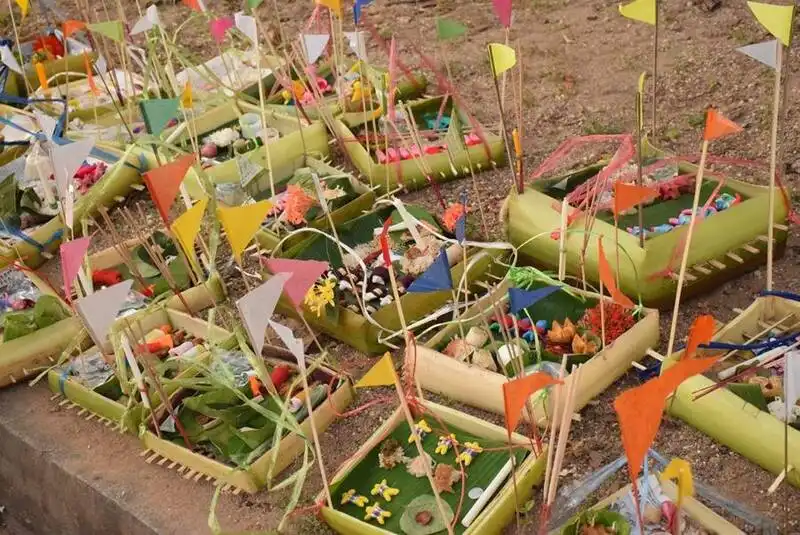The Central Thai Village Merit-Making Tradition

Rating: 5/5 (1 votes)
Bangkok attractions
Attractions in Thailand
The Central Thai Village Merit-Making Tradition: A Cultural Celebration is a significant cultural event for communities in the central plains of Thailand. Held after the rice harvest, usually from mid-March to June according to the Thai lunar calendar, or around February by the solar calendar, this tradition plays a crucial role in fostering community spirit and morale. It is an event deeply valued by the Thai people.
History and Origins The central village merit-making tradition has its roots in the Sukhothai era, evidenced by the discovery of "doll" relics known as "Sia Kabal" or "headless dolls." These artifacts are associated with the practice of merit-making that dates back several centuries. The event is held outdoors in a communal area of the village, a site that has traditionally been used for such gatherings. Some villages construct sand stupas as a mark of the celebration, a practice inspired by religious texts aimed at creating merit through collective worship.
The beliefs surrounding the central village merit-making tradition integrate ancestral veneration with Buddhist principles. It involves honoring ancestors for their blessings of abundance and seeking to alleviate misfortunes for the community. This practice aligns with the agricultural lifestyle of the community and the Theravada Buddhist tradition, emphasizing merit-making through offerings to monks and seeking blessings for prosperity and well-being post-harvest. It is also believed that if a village ceases to perform the merit-making tradition at a specific location, it may bring misfortune to that village.
Steps and Rituals
1. Preparation
- Site Preparation: The event is organized in a spacious area within the village that has historically been used for such ceremonies.
Preparation of Items: This includes preparing food and drinks for the merit-making, constructing sand stupas, and making headless dolls for alleviating misfortune.
2. Main Rituals
- Construction of Sand Stupas: Sand stupas are built as a symbol of collective merit-making and devotion.
Making and Placing Headless Dolls: Headless dolls made of clay are placed at crossroads to ward off bad luck.
Inviting Monks: Monks are invited to chant Buddhist scriptures in the evening and to receive alms the following morning, enhancing the merit and blessings for the village.
3. Community Celebration
- Community Participation: Villagers come together to participate in the merit-making activities, strengthening communal bonds and celebrating together.
The central village merit-making tradition plays a vital role in promoting community unity and preserving cultural and religious beliefs. In modern times, it continues to be significant in fostering community cohesion and maintaining traditional practices. The event supports the cultural heritage and spiritual life of the community, ensuring that these traditions remain vibrant.
Preserving and promoting the central village merit-making tradition involves organizing activities and educating younger generations and communities about its significance. Support from local organizations and relevant authorities is crucial for maintaining and advancing this cultural practice.
The central village merit-making tradition is a valuable aspect of Thai cultural heritage, blending historical, religious, and communal elements. It not only serves as a means of spiritual enrichment and community bonding but also helps preserve the unique cultural identity of Thailand. By continuing to uphold and celebrate this tradition, communities can ensure that their cultural practices remain a strong and integral part of their identity.
Comment
| Keyword (Advance) |
 Facebook Fanpage
Facebook Fanpage

 Category:
Category:  Group:
Group:  Historical Sites and Monuments(
Historical Sites and Monuments( Landmarks and Memorials(
Landmarks and Memorials( Royal Palace(
Royal Palace( Museums(
Museums( Historical Houses and The Ancient City(
Historical Houses and The Ancient City( Art Gallery(
Art Gallery( Educational Places
Educational Places Museum for Study(
Museum for Study( Library(
Library( University
University Places of Worship
Places of Worship Temple(
Temple( Church(
Church( Mosque(
Mosque( Other religious and spiritural sites(
Other religious and spiritural sites( Research and Development
Research and Development Royal Project(
Royal Project( Suburban Living
Suburban Living Village, Community(
Village, Community( Local Market(
Local Market( Floating Market(
Floating Market( Nature and Wildlife
Nature and Wildlife River, Canal(
River, Canal( Bays and Beaches(
Bays and Beaches( Other natural attractions(
Other natural attractions( Entertainment and Agricultural
Entertainment and Agricultural Zoos and Aquariums(
Zoos and Aquariums( Animal camps and shows(
Animal camps and shows( Stadium(
Stadium( Farm, Parks, Gardens and Ecotourism(
Farm, Parks, Gardens and Ecotourism( Amusement Park(
Amusement Park( Waterpark(
Waterpark( Theater(
Theater( Cinema(
Cinema( Shopping
Shopping Shopping and Night Market(
Shopping and Night Market( Department Store(
Department Store( Spas and Wellness
Spas and Wellness Spas and Wellness(
Spas and Wellness( Restaurant
Restaurant Michelin Star(
Michelin Star( Accommodation
Accommodation Hotel(
Hotel( Call Customer Service in Tourism
Call Customer Service in Tourism Call Customer Service in Tourism(
Call Customer Service in Tourism( Travel Articles, Recipes
Travel Articles, Recipes Travel Review, Food Review(
Travel Review, Food Review( Royal Thai Desserts, Traditional Dessert, Thai Dessert Recipes(
Royal Thai Desserts, Traditional Dessert, Thai Dessert Recipes(